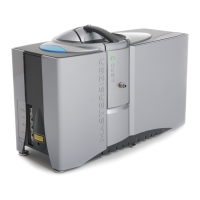Maintenanc e
98
1. Place the cuvette upside down in the wash station. Ensure correct orientation and
the cuvette is firmly in place. The spout should face away from the waste exit/ dis-
persant input.
2. Fill a syringe with some IPA.
Warning!
Make sure the cuvette is fitted correctly before using the syringe, otherwise you
may be sprayed with dispersant or other cleaning chemicals. Eye protection
must be used.
3. Place the syringe into the cleaning inlet.
4. Push the syringe plunger firmly in; this will force the clean dispersant around the
inside of the cuvette.
5. Repeat 3 to 4 times as required.
6. Leave the cuvette to dry upside down on a clean sheet of lint free cloth.
Cleaning after a measurement
After a measurement, clean the cuvette as described below. Once clean the cuvette can be
used for the next measurement sequence.
If cleaning after performing an aqueous measurement.
When cleaning between each individual analysis:
1. Empty the sample and dispersant from the cuvette into a beaker, retrieve the stir-
rer bar, and then discard the sample and dispersant.
2. Clean the cuvette in wash station as described above using clean deionised water.
3. Clean the stirrer bar using clean deionised water using a lint free cloth.
4. The cuvette and stirrer bar can now be used for the next analysis.
Cleaning and storing after all analysis have been completed:

